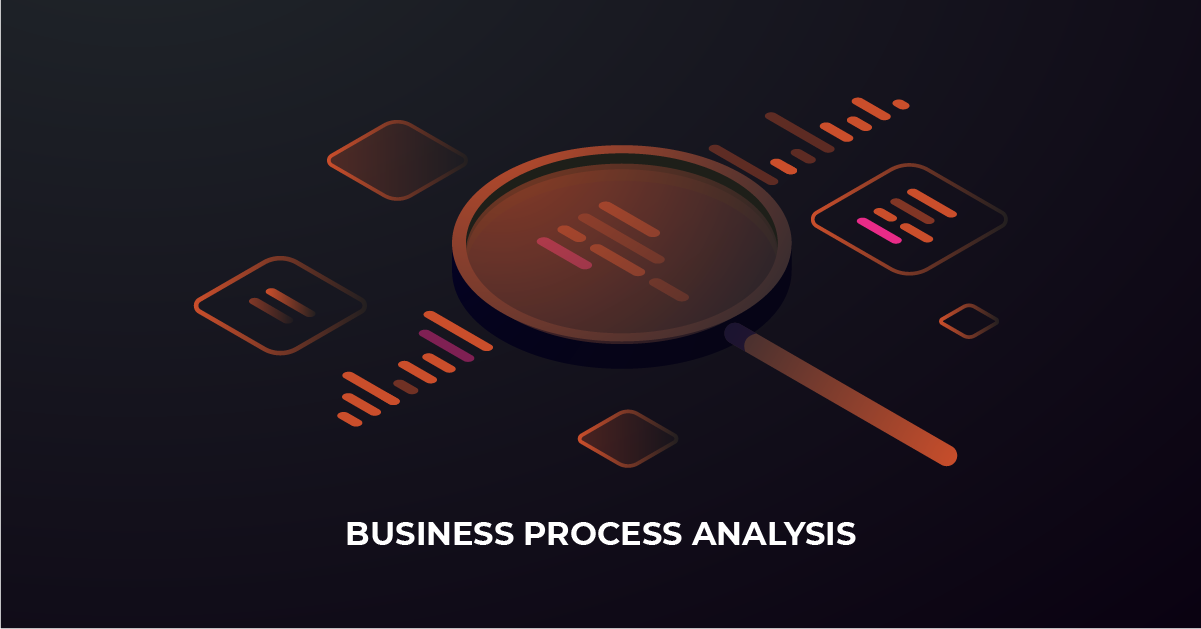Efficient business processes are the principal determinant of how successful any business operation can become.
This guide was developed specifically for business process analysts seeking to roll out modernized business process improvements for maximum efficiency.
One of the most effective methods for achieving this is through business process analysis (BPA). When done right, this can have a major impact on a company’s bottom line.
What is Business Process Analysis? (BPA)
In a nutshell, a business process analysis is an audit of inefficiency and bottlenecks within an organization — countered with an improvement plan to clean up the leakage, minimize waste and streamline various business processes.
This is basically a comprehensive review of inputs and outputs that form various business workflows.
Business Process Analysis vs. Business Analysis
Imagine Business Process Analysis and Business Analysis as two different lenses to view a company.
Business analysis is like taking a step back and evaluating the company’s overall business model, market standing, and strategic direction.
In contrast, Business Process Analysis acts like a microscope, zooming in on the finer details of the company’s workflows and procedures.
Its primary goal is to scrutinize these individual processes and fine-tune them to enhance efficiency and productivity.
This involves understanding the methodology and metrics used in each business process.
Benefits of Business Process Analysis
There are numerous benefits to conducting a Business Process Analysis. Here are some of the key ones:
- Detailed insights into process functionality: A BPA serves as a window, enabling businesses to delve deep into their operations, fetching crucial data about their procedures. These insights facilitate informed decision-making based on hard evidence.
- Structured process blueprints: A byproduct of BPA is the creation of detailed, straightforward documentation of every process. This template is an invaluable resource for training new recruits or as a quick reference guide for anyone partaking in the process. Take sales leadership training for example – earlier stage companies just outsource this. But as a company scales, it’s more efficient in the long-run to build these processes in-house.
- Policy and rule clarification: The exercise of examining and recording processes inevitably shines a light on the company’s internal guidelines and protocols, thus reinforcing compliance and fortifying security measures. By reviewing and refining internal guidelines and protocols, businesses can establish clear rules, robust authorization procedures, and access controls to prevent fraudulent activities and safeguard sensitive data.
- Identification of cost-reducing opportunities: When businesses dissect their processes, they uncover areas where they can potentially reduce expenses without sacrificing the process quality. This might involve identifying redundancies or implementing new technology to streamline operations.
- Discovery of communication loopholes: The in-depth analysis of BPA uncovers any communication gaps or inefficiencies that may exist, thereby allowing businesses to patch these loopholes and enhance internal communication.
- Better team synchronization and cooperation: Gaining a granular understanding of their processes equips businesses to improve the coordination between various teams or departments. This leads to a more synchronized and collaborative work environment.
- Elevating customer experience: Streamlining processes often has a domino effect, leading to an enhanced customer experience. Be it prompt service, superior product quality, better customer engagement or smoother communication – improved processes ultimately result in satisfied customers.
- Laying groundwork for consistent enhancement: Completing a BPA is like setting a benchmark for future improvements. The valuable data collected during the analysis serves as a cornerstone for an ongoing journey of process refinement and optimization.
5 Steps of Business Process Analysis
Business Process Analysis is not a standalone activity; it’s an iterative process involving several steps. The five steps to a robust Business Process Analysis methods include:
Identify your goals and problems
The launchpad for any Business Process Analysis is a lucid definition of objectives and the challenges you aim to address. What are your business goals with this analysis? What obstacles are you looking to overcome? A comprehensive understanding of your objectives will steer the rest of the investigation.
Collect data about the current process
Once you have your objectives and challenges in place, the subsequent phase is data collection pertaining to the existing workflow. This could involve active observation of the process, engaging in conversations with stakeholders, and scrutinizing available documentation. Leveraging project management tools such as ClickUp enhances the efficiency of this phase, aiding in smooth information collection, report generation, and task automation.
Map and analyze your data
Post data accumulation, the next action is creating a process map – a visual depiction of the workflow illustrating each step and their interconnections. This visual aid can be analyzed to pinpoint inefficiencies, bottlenecks, or scopes for enhancement. A flowchart or any other form of visual process map aids in identifying patterns and gaps in your workflow.
Implement changes and monitor
The final phase is business process improvement (BPI), where you act upon the insights from the analysis. Upon evaluating the tools your business employs, you might, for instance, discover that your current subscription to HubSpot is costing more than necessary, and a more affordable alternative would suffice. This strategy can lead to long-term cost reduction.
To sustain continual development and enhancement, it’s vital that this cycle of goal setting, data collection, mapping, plan formulation, execution, and monitoring becomes ingrained in your organization’s standard operating procedures. By doing so, you foster a culture of data-informed decision-making, operational efficiency, and success.
Business Process Analysis Techniques
There are various techniques used for Business Process Analysis, each suited to different situations. Here are some of the most common:
- Gap analysis: This method assists businesses in discerning the discrepancies between their existing situation and their envisioned future, thus illuminating the necessary steps for achieving their objectives.
- Root Cause analysis: The fundamental principle of root cause analysis is delving deeper than the surface-level symptoms to discover the underlying issues. By unearthing the root cause, businesses can introduce solutions that target the issue at its core, eliminating future recurrences.
- SWOT analysis: SWOT Analysis is a method of examining a business’s Strengths, Weaknesses, Opportunities, and Threats. This approach offers a comprehensive perspective of the company’s standing and aids in strategic planning.
- Value-added analysis: This method centers around identifying activities in a process that do not contribute any value. These are activities that don’t enhance the final product or service and can typically be eliminated to boost efficiency.
- Examination of experience: This approach scrutinizes the customer experience to pinpoint areas of potential improvement, leading to enhanced customer satisfaction and boosted loyalty.
Each of these techniques can provide valuable insights, and the best one for your business will depend on your specific situation and needs.
Recommended Business Process Analysis Tools
There are many tools available that can streamline and automate Business Process Analysis. Here are some of the most popular:
1. DCKAP Integrator
DCKAP stands as a beacon of innovation in the realm of business process integration. Catering to a diverse range of industries, including eCommerce, wholesale distribution, and retail, DCKAP has revolutionized the way businesses utilize their Enterprise Resource Planning (ERP) systems. Initially designed to automate core back-office functions, DCKAP has evolved to encompass front-office functionalities, seamlessly integrating eCommerce platforms, sales, and marketing automation.
But what truly sets DCKAP apart is its robust middleware solution, the DCKAP Integrator. This tool effortlessly manages data flow between multiple data points, including CRM and ERP, ensuring a streamlined and efficient data transfer process. With DCKAP, businesses can eliminate the tediousness of manual data entry, reduce human errors, and ensure real-time data availability. Moreover, its capability to integrate with major eCommerce platforms like Adobe Commerce/Magento, Shopify, and SAP Hybris makes it an indispensable tool for businesses aiming for growth and efficiency.
By choosing DCKAP, businesses not only get an integration solution but also a partner that understands the intricacies of modern business operations and the importance of a unified data management system. With its user-friendly interface and powerful integration capabilities, DCKAP is undeniably the top choice for businesses aiming to optimize their processes and achieve unparalleled success.
2. Appian
Appian provides robust business process management (BPM) capabilities. These include process modeling, automation, case management, and monitoring, making it an invaluable tool for business process analysis, as businesses can visualize, analyze, and improve their existing processes directly within the platform.
3. Engage Process
Engage Process is a versatile process management tool that offers an all-in-one solution for businesses looking to optimize their complex processes. The platform provides a suite of features for business process mapping, simulation, and improvement, thereby supporting the full life cycle of business process analysis we’ve discussed above in this article.
What sets Engage Process apart is its visualization capabilities. Businesses can create detailed, interactive internal processes maps that provide clear insights into how their processes operate. Additionally, the simulation feature enables businesses to test potential changes to their processes in a risk-free environment, making it easier to identify the most effective solutions.
4. Heflo
Heflo is a cloud platform for business process management, offering a comprehensive toolset for business process modeling, documentation, execution and management. It’s designed to be user-friendly, with a visually appealing interface that allows users to create and edit process diagrams with ease.
One of Heflo’s key strengths is its process automation feature. Users can design workflows, automate tasks, and monitor the execution in real-time, ensuring efficiency and consistency across business operations. Its analytics capabilities also provide valuable insights into process performance, allowing businesses to identify inefficiencies and optimize their workflows over time.
5. HOPEX Platform
HOPEX Platform improves collaboration and alignment by removing silos and sharing a single source of truth to all business and IT stakeholders.
With HOPEX, businesses can model and visualize their processes, analyze performance, and identify areas for improvement. Its business architecture feature supports strategic planning by providing a holistic view of the organization’s business strategy, capabilities, and resources. The IT portfolio management feature further enhances decision-making by providing insights into IT investments and alignment with business objectives.
6. Signavio
Signavio is a business transformation suite that provides an end-to-end solution for process management. Its capabilities range from process modeling and analysis to workflow automation and process intelligence.
One of Signavio’s unique features is its collaborative process design, which allows team members to contribute to process modeling and improvement initiatives. Additionally, its process intelligence feature uses data-driven insights to help businesses identify business processes that are inefficient, simulate potential changes, and monitor the impact of those changes.
Contents




